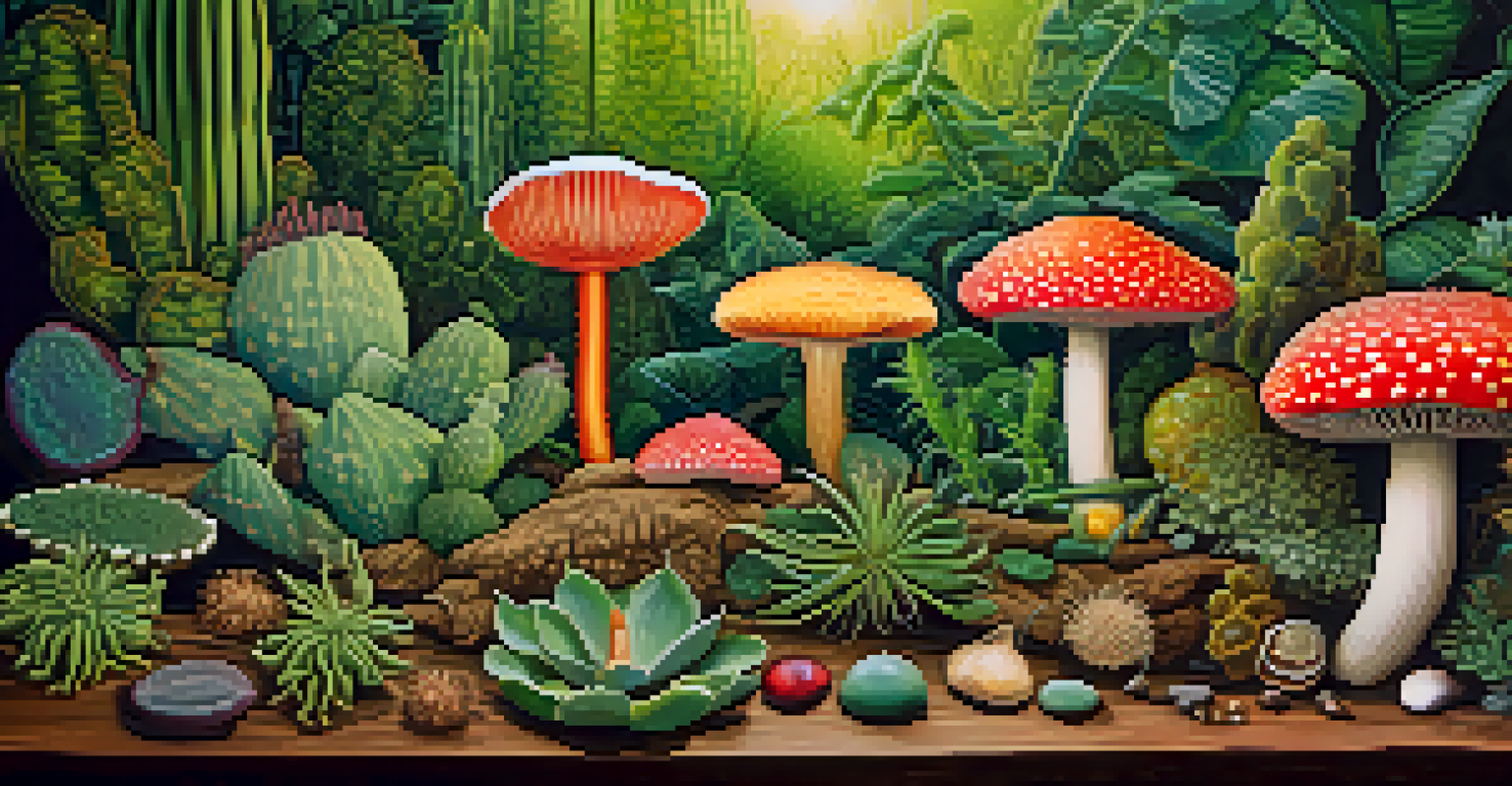Mystical Experiences: Entheogens and Their Impact

What Are Entheogens and Their Historical Context?
Entheogens are substances that can induce altered states of consciousness, often used in spiritual or religious contexts. These substances, which include natural plants and fungi, have been part of human culture for thousands of years. Cultures around the world, from Indigenous tribes to ancient civilizations, have utilized these powerful tools to connect with the divine or explore their inner selves.
The use of psychedelics in a therapeutic setting can lead to profound personal insights and emotional breakthroughs.
Historically, entheogens were revered as sacred and were integrated into rituals and ceremonies. For example, the use of peyote in Native American spirituality highlights the importance of these substances in fostering community and spiritual growth. Understanding this historical context enriches our appreciation for the roles entheogens play in various cultures and their potential to facilitate mystical experiences.
In contemporary society, there’s a resurgence of interest in entheogens, particularly in therapeutic settings. As more people seek holistic methods for personal growth and healing, these substances are gaining recognition for their ability to foster transformative experiences.
The Science Behind Entheogens: How They Work
Entheogens primarily affect the brain's serotonin receptors, particularly the 5-HT2A receptor, leading to altered perceptions and emotional responses. This interaction can result in vivid visual experiences, profound insights, and feelings of interconnectedness. By disrupting normal patterns of thought, these substances can open the door to new ways of understanding oneself and the universe.

Research has shown that entheogens can lead to lasting changes in mood and behavior, which is why they're being studied for therapeutic applications. For instance, psilocybin, the active compound in magic mushrooms, has shown promise in treating depression and anxiety. These findings underscore the potential of entheogens to induce not just temporary shifts but long-lasting transformations.
Entheogens' Cultural Significance
Entheogens have been used for thousands of years in various cultures for spiritual and healing purposes.
Furthermore, the subjective experience of taking entheogens often includes feelings of unity, transcendence, and spiritual awakening. Participants frequently report a sense of clarity and connection that can be life-changing, suggesting that these substances may serve as catalysts for deeper understanding and personal growth.
Common Types of Entheogens: A Brief Overview
Some of the most well-known entheogens include psilocybin mushrooms, ayahuasca, and mescaline. Each of these substances has its own unique effects and cultural significance. For example, ayahuasca, a brew made from Amazonian plants, is traditionally used in shamanic ceremonies and is known for its intense, introspective journeys.
Entheogens offer a unique pathway to understanding consciousness, enabling individuals to explore the depths of their psyche.
Another popular entheogen is the peyote cactus, which has been used for centuries by Native American spiritual leaders to facilitate visions and healing. These plants not only provide profound experiences but also serve as a bridge to understanding ancient wisdom and practices that have stood the test of time.
Lastly, synthetic entheogens like LSD have gained popularity in modern culture, especially during the 1960s counterculture movement. While their effects can vary widely, they often lead to similar mystical experiences and insights, prompting discussions around their benefits and risks in contemporary society.
Mystical Experiences: What Do They Entail?
Mystical experiences induced by entheogens often include feelings of unity, timelessness, and deep personal insight. Many users describe these moments as transcendent, where they feel connected to a greater whole or the universe itself. This sense of oneness can lead to significant shifts in perspective and a re-evaluation of one’s life and values.
Moreover, these experiences are often accompanied by intense emotions, ranging from euphoria to profound peace. For some, this emotional release can be cathartic, allowing them to confront and process suppressed feelings. The rich tapestry of experiences can vary widely, making each journey uniquely personal.
Therapeutic Potential of Entheogens
Recent studies highlight the effectiveness of entheogens like psilocybin in treating mental health conditions such as depression and PTSD.
Importantly, the integration of these mystical experiences into daily life is crucial. Many individuals find it necessary to reflect on their insights and apply them, fostering a deeper understanding of themselves and their relationships with others.
The Therapeutic Potential of Entheogens
In recent years, the therapeutic potential of entheogens has gained significant attention in psychological and psychiatric research. Studies have shown that substances like psilocybin and MDMA can help alleviate symptoms of PTSD, depression, and anxiety when used in controlled settings. This burgeoning field points to the possibility of integrating entheogens into mainstream mental health treatment.
Therapists often guide clients through their experiences, helping them process emotions and integrate insights. This supportive environment can enhance the benefits of entheogenic experiences, leading to breakthroughs that traditional methods may not achieve. As more clinical trials demonstrate positive outcomes, the stigma surrounding these substances begins to diminish.
However, it’s essential to approach this therapeutic use with caution. Ensuring safe environments and trained facilitators can help minimize risks and enhance the overall experience, allowing individuals to explore the depths of their consciousness responsibly.
Navigating the Risks and Considerations
While entheogens can offer profound insights, they also come with risks that must be acknowledged. Individuals with a history of mental health issues may experience exacerbated symptoms or challenging experiences during their journeys. It's crucial for anyone considering the use of entheogens to assess their emotional and psychological readiness.
Additionally, the legal status of many entheogens varies across regions, creating a complex landscape for potential users. Understanding the laws in one’s area is vital, as engaging with these substances can have legal repercussions. Being informed helps individuals make educated choices about their experiences.
Risks and Responsible Use
Despite their benefits, entheogens carry risks that require careful consideration, especially for individuals with mental health issues.
Finally, approaching the use of entheogens with respect and intention can significantly impact the outcomes. Setting a clear purpose and being in a supportive environment can help mitigate risks and enhance the overall experience, making it a more meaningful journey.
The Future of Entheogens in Society
As research into entheogens continues to grow, their potential roles in society are expanding. Many advocates argue for the decriminalization and responsible use of these substances, recognizing their therapeutic benefits and cultural significance. This shift could lead to a greater understanding and acceptance of entheogens in mainstream culture.
Moreover, the integration of entheogens into wellness practices and therapeutic settings could redefine mental health treatment. As more people share their positive experiences, the conversation around entheogens is evolving, challenging long-held stigmas and misconceptions.

Ultimately, the future of entheogens in society may hinge on how we approach their use. By fostering education, research, and open dialogue, we can create a landscape where these substances are respected and understood, allowing individuals to explore their potential safely and meaningfully.